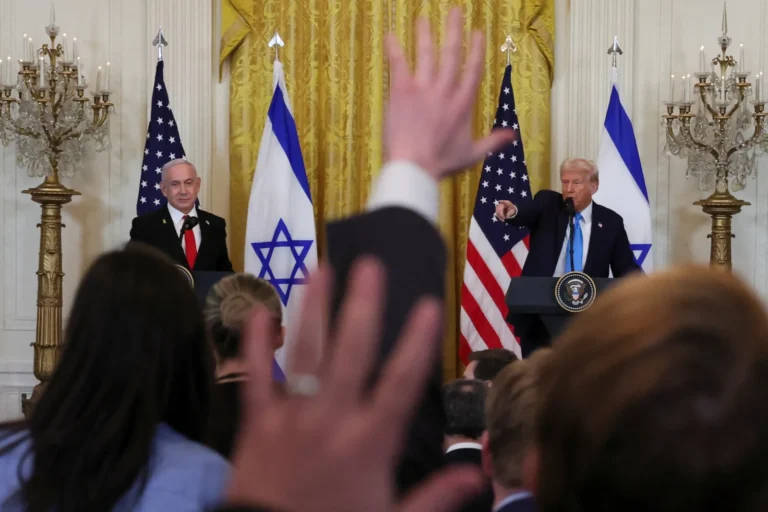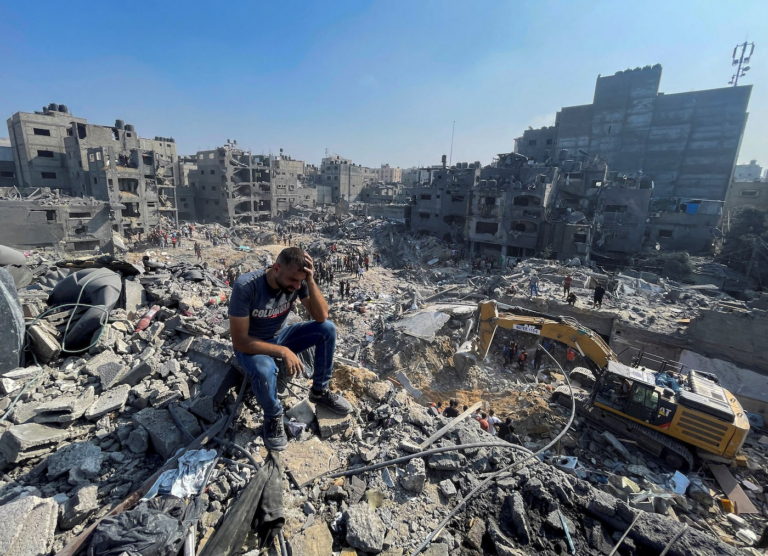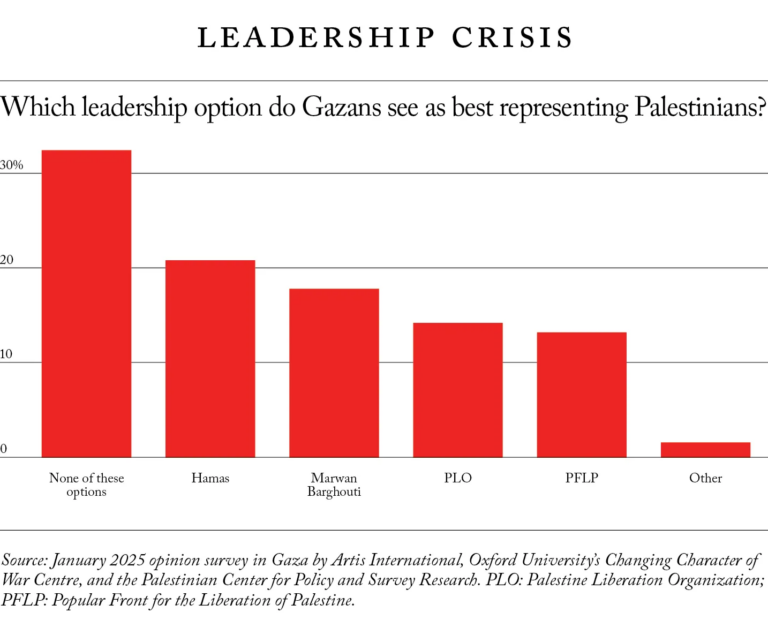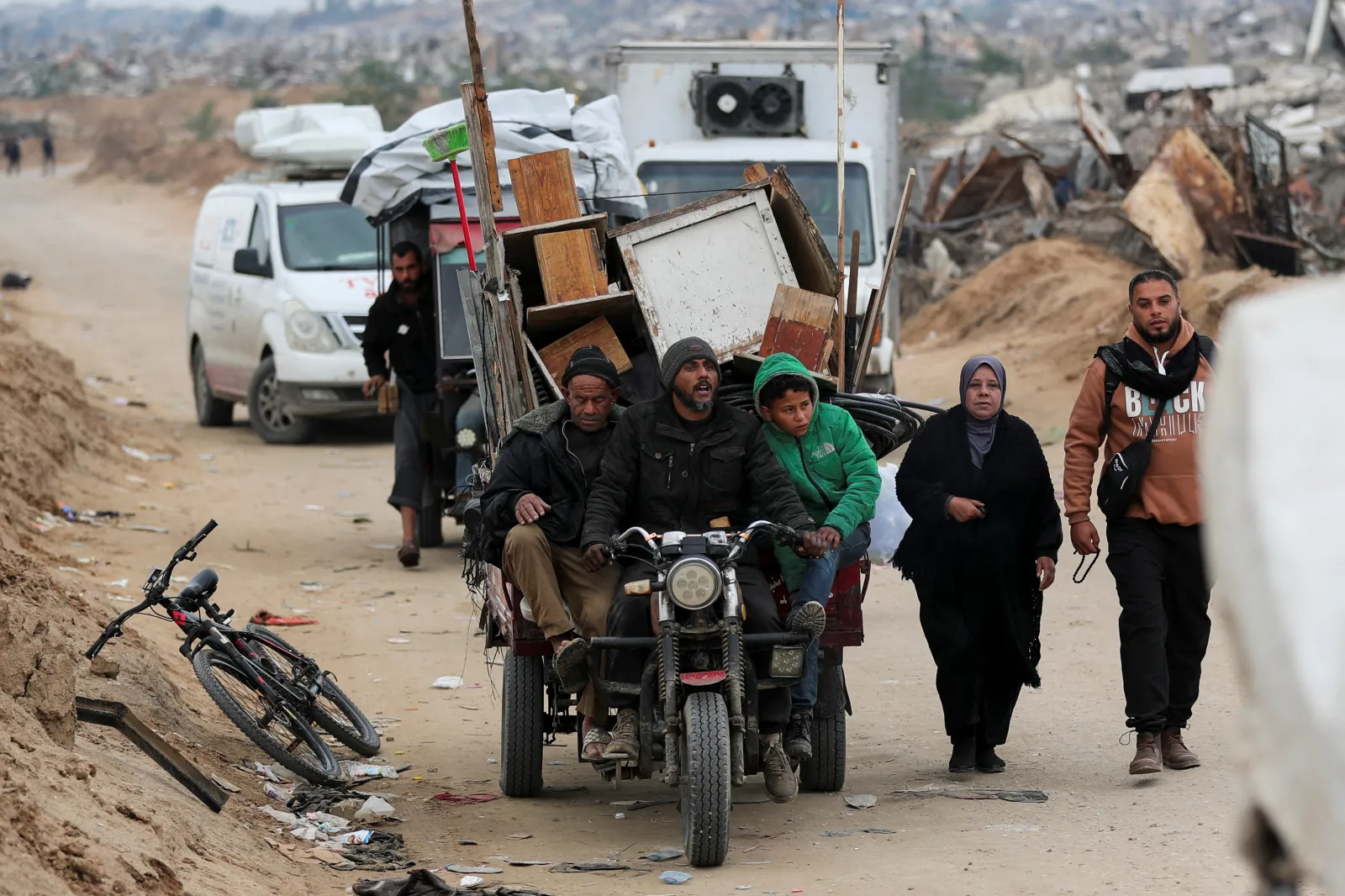A Brutal War Has Weakened Support for Hamas—but Made Peace With Israel Harder

In the weeks since Israel’s fragile January 19 cease-fire and hostages-for-prisoners deal with Hamas, the issue of what should happen to Gaza and its 2.1 million inhabitants has come starkly into view. The war has reduced much of Gaza to ruins, with its schools, hospitals, civilian infrastructure and ecology now largely destroyed and a huge portion of its population lacking adequate shelter. The constant threat of the cease-fire’s breakdown has fueled its own daily dread of further devastation. Even as U.S. President Donald Trump has floated chimerical ideas about an eventual U.S. “takeover” of Gaza and the permanent relocation of its population, external powers have made little progress on formulating a strategy for governance and security in the territory now.
Israel may be further from pacifying Gaza than ever.
Strangely absent from this debate are Gazans themselves. It is reasonable to assume that more than 15 months of pulverizing conflict have changed the perceptions of ordinary civilians in the territory about what they want for their future, how they see their land, who they think should be their rulers, and what they consider to be the most plausible pathways to peace. Given the extraordinary price they have paid for Hamas’s actions on October 7, 2023, Gazans might be expected to reject the group and favor a different leadership. Similarly, outside observers might anticipate that after so much hardship, Gazans would be more prepared to compromise on larger political aspirations in favor of more urgent human needs.
In fact, a survey we conducted in Gaza in early January, shortly before the cease-fire came into effect, tells a more complicated story. The representative survey was formulated by the research group Artis International and Oxford University’s Changing Character of War Centre and carried out by the Palestinian Center for Policy and Survey Research (PSR). Using census data and sampling people in shelters based on the locations of their original homes to ensure geographic diversity, the survey comprised 500 face-to-face interviews with Gazans—248 women and 252 men—ranging in age from 18 to 83. The margin of error was plus or minor 4 percentage points.

The survey found that although Hamas’s popular appeal has declined precipitously since the early months of the war, current alternatives to the group draw even less support, which opens the way for Hamas to shore up its influence over Gaza again. The war has also strengthened rather than weakened Gazans’ commitments to maximalist political goals, while eroding support for a two-state solution. Perhaps most strikingly, the survey showed that the people of Gaza continue to retain strong core values related to their Palestinian and religious identity and their attachment to the land, values that they intend to uphold even if doing so requires great personal sacrifice. As the United States and its regional and international partners confront the reality of postwar Gaza, the survey findings may challenge the assumption that any movement towards peace with Israel can be found that does not satisfy—or at least symbolically recognize—some of these basic values.

THE GOVERNANCE GAP

In one of the primary questions in the survey, respondents were asked to select which of several possible resolutions to the Israeli-Palestinian conflict they viewed as both acceptable and realistic. Before the war in Gaza began, research showed that a clear majority of Palestinians in Gaza supported a two-state solution whereas just 20 percent supported a military solution that could result in the destruction of the state of Israel. In the January survey, less than half, or 48 percent, still preferred a two-state solution, while nearly as many, 47 percent, preferred the dissolution of Israel. A mere five percent viewed a third alternative, a democratic, binational state with equal rights for Arabs and Jews, as acceptable and realistic.
Moreover, although partition was deemed acceptable and realistic by 48 percent, just 20 percent supported a two-state solution conforming to United Nations resolutions based on the 1967 borders. The rest of those supporting a partition favored two-state solutions that either required “right of return” of the descendants of Palestinian refugees to homes in Israel (17 percent) or reverting to the 1947 UN partition plan for Palestine (11 percent). Of the 47 percent who favored Israel´s dissolution, a clear majority opted for a single state under sharia law that would tolerate a Jewish presence but allow Jews less than full rights (27 percent), followed by a smaller group that sought the transfer of Jewish immigrants and their descendants—but not Jews whose ancestors lived in the region before Zionism—from Israel proper and the Palestinian territories (20 percent).

The survey also showed how Gazans’ views of Hamas have changed. Before October 7, 2023, when the Gaza Strip was still intact, polls showed that popular support for Hamas had been withering for some time. The decline resulted from a variety of factors, including stagnant living conditions and a lack of movement on Hamas’s promise of armed resistance against Israel and toward the creation of a Palestinian state. As PSR’s director, Khalil Shikaki, has argued, the October attack might be viewed as an attempt by Hamas to break out of a politically intolerable status quo.


During the initial months of war, Gazans’ attitudes toward Hamas improved. In March 2024, a PSR poll of Gazans found that support for Hamas’s control of the strip had increased to more than 50 percent, a 14-point rise from before the October 7, 2023, attack. At the time, most Gazans believed that Hamas would continue to control the territory and that it was winning the war against Israel. By January 2025, however, after the decimation of the group’s top leadership and further destruction of Gaza, that surge of support had eroded again.
Our January survey found that Hamas retains the support of only a fifth of Gaza’s population—a steep decline from the March poll. Yet support for other political factions, including the Palestine Liberation Organization, was even lower. In fact, when asked to select from among the current options for Palestinian leadership, Gazans’ most frequent response was that none of them truly represented the people. Indeed, Gazans believe that Israel’s leadership does a much better job of representing Israelis than Palestinian leadership does representing Palestinians.
In short, the survey reveals a Palestinian leadership vacuum that Hamas, as degraded as it is, is rapidly working to fill. As some analysts have observed, the organization’s reassertion of power has been aided by the absence of a viable alternative plan for Palestinian governance from Israel or the United States and by the Trump administration’s talk of a proposal long championed by the Israeli far right: population “transfer.” According to Shikaki, most Gazans do not believe that Hamas has won the war. “Nonetheless,” he adds, “they do not seem to find a better alternative.”
THE STRENGTH WITHIN
The lack of strong support for Hamas may obscure a larger reality about the role the group plays in Gaza. As our survey results indicate, despite Gazans’ perceptions of a crisis in Palestinian political leadership, a majority of the population continues to be committed to Hamas’s political ideals, such as sharia as the law of the land, the right of Palestinian refugees and their descendants to return to the homes they lost in Israel´s creation in 1948, and the quest for national sovereignty for Palestinians.
We measure such commitment by first asking participants to drag a small circle (“Me”) to a position that best affirms their relationship to a large circle representing a Value or a Group. They are considered “fused” with the value or group when they place themselves in the very center of the large circle. Findings from prior studies, from the battlefields of Libya and Ukraine to America´s culture wars, suggest that those who show total fusion see the value or group as a visceral and inseparable part of their identity.
Fusion is one reliable predictor of willingness to make sacrifices for a group or greater cause. Another predictor of self-sacrifice is when the group cause becomes a “sacred value.” Whether religious or secular, like God or country, sacred values are non-negotiable, regardless of material risks, rewards, costs, or consequences. When fusion and sacred values are both present they produce “devoted actors” willing to sacrifice all, including their lives and loved ones, the totality of their self-interests.
Between 2015 to 2017, for example, we conducted a series of studies in Iraq of groups—the Islamic State, or ISIS; the militant Kurdish separatists of the PKK; and the Kurdish peshmerga, or military forces of Iraqi Kurdistan—that kept fighting despite high numbers of casualties. We found that members of these fused groups tended to show a high degree of willingness to sacrifice themselves for values they held sacred, a characteristic that gave these groups a spiritual strength that significantly outweighed their physical or material resources, such as firepower, manpower, logistical support, or training time.
This is also true for Gazans after 15 months of war. As the January survey found, inhabitants of the strip show a high degree of group identification as Palestinians, and many express a willingness to make costly personal sacrifices to achieve specific goals such as sharia as the law of the land, the right of refugees and their descendants to return to the homes they lost in Israel´s creation in 1948, and the quest for national sovereignty for Palestinians. For each of these core values, the more that respondents are prepared to make costly sacrifices for them, the less willing they were to make peace with Israel.
To measure how Gazans view their physical and spiritual strength relative to other national groups, the survey used an approach that has previously been used in surveys of Iraqis, Ukrainians, and the U.S. armed forces, among others. Respondents are shown a pair of semi-nude bodies side by side with national flags attached to their heads, which can be increased or decreased in size and musculature using a slider. They are then told to move the slider to assess the relative “physical” and “spiritual” strength of each national group. In our survey, Gazans were asked to compare themselves with Israelis, Americans, and Iranians. The respondents considered Palestinians to be far stronger spiritually than they are physically. This was the opposite of how they perceived Israel, the United States, and even their own putative ally Iran, which they viewed as much stronger physically than spiritually.
Gazans also show a marked tendency to view the conflict with Israel in religious rather than political terms, as a conflict to liberate Muslims from Jewish oppression. But Palestinians’ religious belief does not necessarily imply intolerance of other groups. For example, in a 2016 survey of Palestinian Muslim youths, we and colleagues found that many were disposed to place much greater value on the lives of Palestinians than on those of Jewish Israelis. Yet when they were asked to take the viewpoint of Allah (God), they valued the two more equally. Their belief in God appeared to promote a more universal valuation of human life, attributing moral worthiness to Muslims and non-Muslims alike even amid prolonged conflict.
Nevertheless, when religion becomes identified with an assertive sociopolitical agenda ostensibly sanctified by God or a “party of God,” opponents to that agenda and party become enemies of God who are easier to vilify and kill. In the January survey, barely one percent of Gazans considered themselves “not religious,” whereas 67 percent identified themselves as “somewhat religious” and 31 percent as “truly religious.” The nearly one-third of respondents identifying themselves as “truly religious” were most committed to the sovereignty of Palestine and the right of return and most willing to make major sacrifices, including fighting and dying, for those outcomes. This segment was also most likely to support sharia and Hamas’s leadership of Gaza and of Palestinians in general.
The “truly religious” and “somewhat religious” alike judged Israelis to be significantly less human than Palestinians. The survey tested this by asking respondents to place Palestinians and Israelis on a visual scale ranging from an ape-like figure on through stages of semi-erectness to a fully upright human. Studies from China, Europe, India, North America, and elsewhere indicate that the less human the chosen figure, the more respondents associate the adversary with moral degeneracy and violent threats and actions, and the greater their own impetus for violence against that adversary.
THE PRICE OF PEACE
It is important to note that for most Gazans, religious and political commitments are not all-determining. Although most Gazans consider the basic values associated with being Palestinian as central to their identity, only smaller minorities consider these values to be nonnegotiable. For example, only 30 percent of Gazans view the right of return as a nonnegotiable part of their identity; just 20 percent view sharia that way; and 15 percent, national sovereignty. Nonetheless, respondents judged that even the cause of national sovereignty was significantly more important than preserving family safety and security—a finding that parallels survey results from the most committed combatants for and against ISIS during its period of maximum control in Iraq in 2015-16.
There may be a broader takeaway from these findings about Gazans’ deep spiritual commitment to Palestinian core values. In similar studies conducted elsewhere, groups that perceive themselves as relatively weak physically but strong spiritually tend to be those that are more militant or radicalized and willing to continue fighting, even against a far more powerful foe. They perceive their readiness for self-sacrifice as an advantage over their adversaries. This is a common trait among extremist groups, such as fighters and supporters of ISIS or the Kurdish PKK, but also among others who may be just as devoted and willing to sacrifice themselves for democracy or peace (as seen in a much smaller percentage of the population in Gaza).
For Gazans more widely, the willingness to sacrifice themselves for common goals this far into a brutal war strongly suggests that they are unlikely to give up their struggle simply in exchange for personal and family security. This raises questions about various international “day after” plans in Gaza, which seem to assume that providing personal safety and livelihood—cessation of hostilities combined with aid delivery, tents, and basic necessities—can stabilize the territory even without Palestinian self-determination.

To assess how Gazans now see the chances for peace in the future, the survey assessed their expectations about scenarios endorsed in the past by Palestinian leaders, including Hamas officials. Years before the October 7, 2023, attack, one of us (Atran) conducted several interviews with Hamas leaders, including in 2006 then-Gaza Prime Minister Ismail Haniyeh, who later served as politburo chairman until his assassination by Israel last year; then-politburo chairman Khaled Meshal in Damascus in 2009; and deputy chairman Musa Abu Marzouk in Cairo in 2013. In each of these cases, the leaders indicated an openness to a long-term truce or even peace with Israel.
Our January survey reminded respondents of these statements, noting that those leaders generally conditioned a truce or a longer peace on Israel’s return to 1967 borders, an internationally backed “balance of power” with Israel, and the recognition of the right of return. The survey then asked which of three outcomes—truce, peace, or more war—seemed most likely for the next generation of Palestinians.
About half of the respondents said they expected peace, 44 percent expected a long-term truce, and seven percent expected more war. Of the roughly half that anticipated peace, however, two groups emerged, almost equal in size: those who expect peace as a negotiated outcome (24 percent) and those who expect peace to arise from Israel’s dissolution (25 percent). Respondents who expected a provisional truce or war believe that Israelis and Palestinians will not reach a permanent peace either because the concessions needed are spurned by the opposing side or are too painful to contemplate by one or both sides.
WHY THEY FIGHT
Paradoxically, the continued strength of Gazans’ commitments to the Palestinian cause may point to forms of compromise that have until now been overlooked. For example, it is no secret that Hamas is committed to a sovereign Palestinian state, the right of return, and sharia law—all of which the elimination of Israel as a state would accomplish. Yet Hamas leaders have in the past suggested that they do not consider a sovereign Palestine “from the river to the sea” and the dissolution of Israel as nonnegotiable, sacred values. Studies we conducted from 2006 to 2013 indicated that even the right of return, though held to be sacred, can be reframed so as to remain nonnegotiable in principle but negotiable in practice.
Such an accommodation might require, for example, meaningful symbolic gestures from the other side, such as a sincere Israeli apology for the expulsion of Palestinians from their homes and lands, Israel’s acceptance of the return of a limited number of refugees and their descendants, and some form of diya, or financial compensation to victims or the heirs of victims of the Nakba, the mass displacement of Palestinians during Israel’s founding in 1948, as a form of historic reparations. But our research also shows that economic incentives or sanctions that aim to compel Palestinians (or Israelis) to forsake their core values backfire for the population as a whole, increasing resistance to peace deals and support for violence.
Of course, Hamas leaders making such statements may have been engaging in insincere posturing aimed at relieving Israeli military pressure, as Israeli leaders have claimed. Nevertheless, in our recent survey, Gazans suggested they were willing to countenance an outcome that fell short of what they considered to be most acceptable and realistic. Establishing a balance of power to ensure that Israel can no longer deploy enough military force to dominate internationally recognized Palestinian territory is a negotiable material good that would ensure Palestinians’ physical security. For those Gazans for whom right of return is a nonnegotiable sacred value, but nonetheless open to reinterpretation, the Israeli recognition of that right, even if largely symbolic would provide a measure of security for the Palestinian people, by upholding what Palestinians often cite as the conflict’s central issue, “land and honor.” Such a gesture, while not sufficient on its own, could well jump start consideration of peace.
By contrast, Gazans believe that abandoning their land, as Trump has proposed, would mean ceasing to be Palestinian. Absent an Israeli willingness to make some concessions on Palestinian core values and a U.S. willingness to enforce the terms of such an agreement, the survey suggests that Gazans will fight on—at least if the committed minority of devoted actors are still able to inspire people to take on unfathomable odds to seek the dissolution of Israel. And Israelis would assuredly respond with incomparably greater destructive force.
After waging 15 months of “total war” and achieving many of its declared material objectives, Israel may be further from pacifying Gaza than ever. This is not just because Israel has failed to offer anything resembling a political strategy or a plausible plan for a Palestinian future, while further radicalizing Palestinians to seek revenge for relatives killed and homes lost. (Our survey shows a positive association between having experienced family displacement and preferring a military over a diplomatic end to the conflict.) It is also because Gazans, at least the most committed among them, believe that their identity and place in the world are more imperiled than ever: a sentiment not unlike the one that inspired the establishment of the Jewish state and fostered its people’s still intense will to fight.



COMMENTS